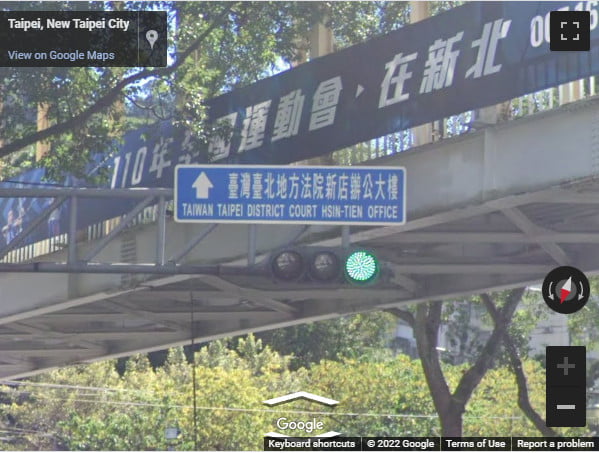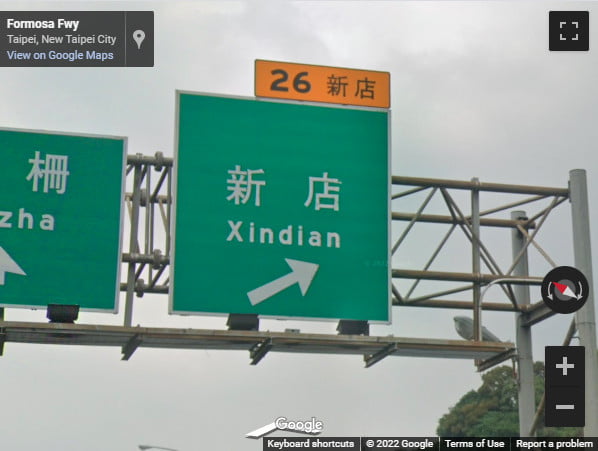“Romanization or romanisation, in linguistics, is the conversion of writing from a different writing system to the Roman (Latin) script, or a system for doing so.”
For Mandarin Chinese different systems were developed. These are the non-Chinese systems: Missionary system, Wade-Giles, French EFEO system, Postal romanization, Yale system. And then there are the Chinese systems: Qieyin Xinzi, Gwoyeu Romatzyh, Latinxua Sinwenz, Hanyu Pinyin. I am not going to explain each of these systems here. There is plenty of information available on the internet. Hanyu Pinyin is the official standard of romanization in the People’s Republic of China (PRC) and has also become more or less a global standard. Everyone who learns Chinese, also learns Hanyu Pinyin.
Still no standard romanization in Taiwan
However, in Taiwan or the Republic of China (ROC) things are a little bit different and a bit more complicated. During Taiwan’s history different romanization systems have been used, for example missionary systems, Wade-Giles, Chinese postal romanization, Gwoyeu Romatzyh, Tongyong Pinyin, Hanyu Pinyin. But no official standard was implemented until recent years. After long discussions Hanyu Pinyin was adopted as the standard romanization in Taiwan in 2009. This mish-mash of romanization systems and often improper use has led to a strange situation in which today different systems exist parallel.
And to make things worse, there is no strict rule to use Hanyu Pinyin consequently everywhere in Taiwan. Local governments have a choice and can use a romanization that suits them, for example Taipei City uses Hanyu Pinyin to romanize street names, but neighboring New Taipei City uses Tongyong Pinyin. Additionally, romanization systems are not taught in Taiwanese schools, so people in Taiwan do not really know how to use Hanyu Pinyin or Tongyong Pinyin correctly, which results often in wrong romanization of names.
To learn more about romanization in Taiwan, I suggest to have a look at these websites
- Wikipedia article about Chinese language romanization in Taiwan
- Romanization.com
- Pinyin.info
Zhu, Chu or Ju?
This road sign in Hsinchu shows the directions to 新竹 (Hsinchu), 竹北 (Zhubei) and 竹東 (Zhudong). Please note that the character 竹 is romanized as zhu and chu at the same time.

And here comes the fun part. This road sign is near the one shown above and it shows the direction to 竹東 (Zhudong) but in this case it is romanized as Judung.

Xin, Hsin or Sin?
Another nice example is the character 新 which is sometimes romanized as hsin like in Hsinchu (新竹), or as xin as in Xindian (新店).


But 新 can also become sin as in this road sign were the same freeway entrance as shown above becomes Sindian Interchange.

The problem with this
I am definitely not the first one who complains about this. Since it is a local phenomenon, it should not bother people outside of Taiwan. However, there are situations were failed romanization has an effect to people outside of Taiwan. In scientific literature correct use of location names is important, especially in geosciences. Otherwise people do not know about which place someone is talking. And because scientific publications are mostly in English these days, Taiwanese location names need to be romanized. But the location names appear without Chinese characters, which could help to identify the correct location name.
As mentioned earlier, Taiwan had no standard and still has no real standard for romanization. Furthermore, people here do not know how to romanize names properly because they did not learn it in school. The result is that many different writings of the same location name exist. Which is a big problem for people who are not familiar with romanization systems and have a limited knowledge about the local geography of Taiwan.
Different writing for the same location
For example, 新店 can be found in Taiwan romanized as Xindian, Hsintien or Sindian. Without Chinese characters, these three names represent three different locations. Even though they might sound a bit similar, but for non-Chinese speakers or people who have no clue of romanization systems, it is difficult to identify these three names as the same location. Same goes for the example above with Zhudong and Judung. Can someone not familiar with Chinese tell that these are the same places?
During my research about microplastic pollution in north Taiwan’s rivers, I came across a great variety of different names for the same rivers. For some of them I needed a good amount of imagination to figure out which river this is. Here I am presenting an incomplete list of different romanizations used for the Tamsui River, the Dahan River, the Keelung River, and the Xindian River.
My goal with this is to demonstrate the importance of a standard romanization system. Even if Taiwanese do not need it, it becomes crucial for communication with the non-Chinese speaking world. Additionally, a lot of research is lost when informal or incorrect romanized location names were used.
I also need to mention that there are is a large number of publications using the correct official names. Not that someone thinks everything is a mess here.
淡水河 Tamsui River
This one is problematic as the local government decided in 2011 to change the name from Danshui River (which was a correct romanization of the Chinese name) to Tamsui River, which was the historic name. In this article the issue of name change is discussed in greater detail.
In different romanization systems the river name would be:
- Hanyu Pinyin: Dànshǔi Hé
- Wade-Giles: Tan4-shui3 Ho2
- Pe̍h-ōe-jī: Tām-chúi-hô
These are the names which were used in different publications:
- Danshui River (Hung et al. 2006; Hung et al. 2007; Huang et al. 2012; Lee et al. 2014; Chen et al. 2019) [side note: using this name was actually correct before 2011]
- Danshuei River (Wang et al. 2004; Hwang et al. 2009; Jiann et al. 2009)
- Tanshui River (Tzeng & Wang 1993; Fang 2000; Huang & Lin 2003; Liu et al. 2008; Hsie et al. 2010; Chen et al. 2012)
- Tan-Sui River (Liu et al. 2000)
- Tansui River (Wu 1999)
- Tam-Shuei River (Doong et al. 2002)
- Tamshuei River (Yuan et al. 2001)
新店溪 Xindian River
Sometimes it is also called Xindian Creek, which is a direct translation of the Chinese character 溪. However, this river is bigger than a creek and the downstream sections are clearly a river. Therefore, it is better to call it a river, like in the official name.
In different romanization systems the river name would be:
- Hanyu Pinyin: Xīndiàn Xī
- Wade-Giles: Hsin1-tien4 Hsi1
- Pe̍h-ōe-jī: Sin-tiàm-khe
And this is how the river was named in scientific publications:
- Hsintian Creek (Chen et al. 2019)
- Hsintian River (Fang 2000; Chen et al. 2012)
- Hsintian Stream (Wang et al. 2004)
- Hsin Tien Stream (Yuan et al. 2001)
- Hsin-dan River (Yang 1998)
- Shindian River (Chen 2005)
- Shindien Stream (Jiann et al. 2009)
- Shin-dan River (Hung et al. 2007)
- Singdian River (Huang et al. 2012; Lee et al. 2014)
- Tsin-Tien Creek (Liu et al. 2000)
- Xindian Stream (Wang et al. 2014; Jang 2016)
大漢溪 Dahan River
Nothing wrong with this name. Dahan River is a good example that shows how important the correct use of romanization is, because there is another river in Taiwan called 大安溪 Da’an River. And Dahan and Da’an sound very similar.
In different romanization systems the river name would be:
- Pinyin: Dàhàn Xī
- Pe̍h-ōe-jī: Tāi-hàn-khe (also spelled Tahan)
And this is how the river was named in scientific publications:
- Dahan Stream (Jiann et al. 2009; Wang et al. 2014; Jang 2016;)
- Dahan Creek (Chen et al. 2019)
- Darhan River (Chen 2005)
- Da-han River (Doong et al. 2002; Hung et al. 2007)
- Da-Han Creek (Liu et al. 2000)
- Daihan Stream (Yuan et al. 2001)
- Tahan River (Fang 2000; Chen et al. 2012; Huang et al. 2012)
- Tahan Stream (Wang et al. 2004)
基隆河 Keelung River
The name for Keelung River is the historic name of the city and the river. It was used since a long time, so I think that Taiwanese people are quite familiar with it. The majority of publications used the official writing for Keelung River.
In different romanization systems the river name would be:
- Pinyin: Jīlóng Hé
- Wade-Giles: Chi1-lung2 Ho2
- Pe̍h-ōe-jī: Ke-lâng-hô
And this is how the river was named in scientific publications:
- Jilong River (Wang et al. 2014) [side note: The authors used correctly Hanyu Pinyin to romanize the name, but they were tricked by the government, who decided to use a historic name for this river.]
- Kee-Long River (Liu et al. 2000)
- Kee-Lung River (Doong et al. 2002)
If you like this content and don’t want to miss new blog posts, consider subscribing to our newsletter!
References
Chen, C. S. (2005). “Ecological risk assessment for aquatic species exposed to contaminants in Keelung River, Taiwan.” Chemosphere 61(8): 1142-1158.
Chen, S. K., et al. (2019). “Assessment of spatiotemporal variations in river water quality for sustainable environmental and recreational management in the highly urbanized Danshui River basin.” Environ Monit Assess 191(2): 100.
Chen, Y. C., et al. (2012). “Estimation of river pollution index in a tidal stream using kriging analysis.” Int J Environ Res Public Health 9(9): 3085-3100.
Doong, R.-A., et al. (2002). “Distribution and fate of organochlorine pesticide residues in sediments from the selected rivers in Taiwan.” Chemosphere 48(2): 237-246.
Fang, T. H. (2000). “Partitioning and Behaviour of Different Forms of Phosphorus in the Tanshui Estuary and One of its Tributaries, Northern Taiwan.” Estuarine, Coastal and Shelf Science 50(5): 689-701.
Hsieh, H. L., et al. (2010). “Effects of semidiurnal tidal circulation on the distribution of holo- and meroplankton in a subtropical estuary.” J Plankton Res 32(6): 829-841.
Huang, J. C., et al. (2012). “Stream discharge characteristics through urbanization gradient in Danshui River, Taiwan: perspectives from observation and simulation.” Environ Monit Assess 184(9): 5689-5703.
Huang, K.-M. and S. Lin (2003). “Consequences and implication of heavy metal spatial variations in sediments of the Keelung River drainage basin, Taiwan.” Chemosphere 53(9): 1113-1121.
Hung, C. C., et al. (2007). “Relationships between pesticides and organic carbon fractions in sediments of the Danshui River estuary and adjacent coastal areas of Taiwan.” Environ Pollut 148(2): 546-554.
Hung, C. C., et al. (2006). “Relationship between carbonaceous materials and polychlorinated biphenyls (PCBs) in the sediments of the Danshui River and adjacent coastal areas, Taiwan.” Chemosphere 65(9): 1452-1461.
Hwuang, J.-S., et al. (2009). “Rank-Abundance Allocations as a Tool to Analyze Planktonic Copepod Assemblages off the Danshuei River Estuary (Northern Taiwan).” Zoological Studies 48(1): 49-62.
Jang, C. S. (2016). “Using probability-based spatial estimation of the river pollution index to assess urban water recreational quality in the Tamsui River watershed.” Environ Monit Assess 188(1): 36.
Jiann, K.-T. and L.-S. Wen (2009). “Intra-annual variability of distribution patterns and fluxes of dissolved trace metals in a subtropical estuary (Danshuei River, Taiwan).” Journal of Marine Systems 75(1-2): 87-99.
Lee, T. Y., et al. (2014). “Speciation and dynamics of dissolved inorganic nitrogen export in the Danshui River, Taiwan.” Biogeosciences 11(19): 5307-5321.
Liu, C., et al. (2000). “Chemical characterization of Tan‐Sui River sediment in North Taiwan.” Toxicological & Environmental Chemistry 76(3-4): 205-218.
Liu, J. P., et al. (2008). “Flux and fate of small mountainous rivers derived sediments into the Taiwan Strait.” Marine Geology 256(1–4): 65-76.
Tzeng, W.-N. and Y.-T. Wang (1993). “Hydrography and distribution dynamics of larval and juvenile fishes in the coastal waters of the Tanshui River estuary, Taiwan, with reference to estuarine larval transport.” Marine Biology 116: 205–217.
Wang, C.-F., et al. (2004). “Residence time of the Danshuei River estuary, Taiwan.” Estuarine, Coastal and Shelf Science 60(3): 381-393.
Wang, Y. B., et al. (2014). “Spatial pattern assessment of river water quality: implications of reducing the number of monitoring stations and chemical parameters.” Environ Monit Assess 186(3): 1781-1792.
Wu, J.-T. (1999). “A generic index of diatom assemblages as bioindicator of pollution in the Keelung River of Taiwan.” Hydrobiologia 397: 79-87.
Yang, S.-S. (1998). “Methane Production in River and Lake Sediments in Taiwan.” Environmental Geochemistry and Health 20: 245–249
Yuan, S. Y., et al. (2001). “Biodegradation of phenanthrene in river sediment.” Chemosphere 43(3): 273-278.




😀 What was sometimes really confusing for us while traveling this counrty is pretty annoying when you want to publish scienitfic stuff. I can feel with you.
Danke für die sehr interessante Recherche. 👍👍👍
Hanyu Pinyin is only used in China, in order to make difference from them, officials offered different versions of spelling due to politics without quitting Mandarin. Pe̍h-ōe-jī is spelled by Taiwanese language, which is different from Mandarin, though some people still write by Chinese characters and that is why some of the foreigners feel confused. Even in Taiwanese language, there are two main different spelling methods.